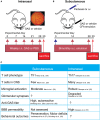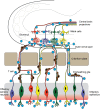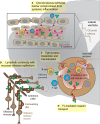Hello from the Other Side: How Autoantibodies Circumvent the Blood-Brain Barrier in Autoimmune Encephalitis
- PMID: 28484451
- PMCID: PMC5399040
- DOI: 10.3389/fimmu.2017.00442
Hello from the Other Side: How Autoantibodies Circumvent the Blood-Brain Barrier in Autoimmune Encephalitis
Abstract
Antibodies against neuronal receptors and synaptic proteins are associated with autoimmune encephalitides (AE) that produce movement and psychiatric disorders. In order to exert their pathological effects on neural circuits, autoantibodies against central nervous system (CNS) targets must gain access to the brain and spinal cord by crossing the blood-brain barrier (BBB), a tightly regulated gateway formed by endothelial cells lining CNS blood vessels. To date, the pathogenic mechanisms that underlie autoantibody-triggered encephalitic syndromes are poorly understood, and how autoantibodies breach the barrier remains obscure for almost all AE syndromes. The relative importance of cellular versus humoral immune mechanisms for disease pathogenesis also remains largely unexplored. Here, we review the proposed triggers for various autoimmune encephalopathies and their animal models, as well as basic structural features of the BBB and how they differ among various CNS regions, a feature that likely underlies some regional aspects of autoimmune encephalitis pathogenesis. We then discuss the routes that antibodies and immune cells employ to enter the CNS and their implications for AE. Finally, we explore future therapeutic strategies that may either preserve or restore barrier function and thereby limit immune cell and autoantibody infiltration into the CNS. Recent mechanistic insights into CNS autoantibody entry indicate promising future directions for therapeutic intervention beyond current, short-lived therapies that eliminate circulating autoantibodies.
Keywords: NMDA receptor; Sydenham’s chorea; autoantibodies; autoimmune encephalitis; basal ganglia encephalitis; blood–brain barrier; dopamine receptor; pediatric autoimmune neuropsychiatric disorders associated with streptococcal infections.
Figures



Similar articles
-
Th17 lymphocytes drive vascular and neuronal deficits in a mouse model of postinfectious autoimmune encephalitis.Proc Natl Acad Sci U S A. 2020 Mar 24;117(12):6708-6716. doi: 10.1073/pnas.1911097117. Epub 2020 Mar 11. Proc Natl Acad Sci U S A. 2020. PMID: 32161123 Free PMC article.
-
Antibodies to surface dopamine-2 receptor in autoimmune movement and psychiatric disorders.Brain. 2012 Nov;135(Pt 11):3453-68. doi: 10.1093/brain/aws256. Epub 2012 Oct 11. Brain. 2012. PMID: 23065479
-
[Autoantibodies Associated with Autoimmune Basal Ganglia Disorders].Brain Nerve. 2018 Apr;70(4):363-369. doi: 10.11477/mf.1416201009. Brain Nerve. 2018. PMID: 29632284 Japanese.
-
Autoantibodies in movement and psychiatric disorders: updated concepts in detection methods, pathogenicity, and CNS entry.Ann N Y Acad Sci. 2015 Sep;1351:22-38. doi: 10.1111/nyas.12764. Epub 2015 Jun 17. Ann N Y Acad Sci. 2015. PMID: 26083906 Review.
-
Autoantibodies in CNS Trauma and Neuropsychiatric Disorders: A New Generation of Biomarkers.In: Kobeissy FH, editor. Brain Neurotrauma: Molecular, Neuropsychological, and Rehabilitation Aspects. Boca Raton (FL): CRC Press/Taylor & Francis; 2015. Chapter 29. In: Kobeissy FH, editor. Brain Neurotrauma: Molecular, Neuropsychological, and Rehabilitation Aspects. Boca Raton (FL): CRC Press/Taylor & Francis; 2015. Chapter 29. PMID: 26269907 Free Books & Documents. Review.
Cited by
-
An exploratory study of the damage markers NfL, GFAP, and t-Tau, in cerebrospinal fluid and other findings from a patient cohort enriched for suspected autoimmune psychiatric disease.Transl Psychiatry. 2024 Jul 24;14(1):304. doi: 10.1038/s41398-024-03021-8. Transl Psychiatry. 2024. PMID: 39048548 Free PMC article.
-
Systematic Review: Syndromes, Early Diagnosis, and Treatment in Autoimmune Encephalitis.Front Neurol. 2018 Sep 5;9:706. doi: 10.3389/fneur.2018.00706. eCollection 2018. Front Neurol. 2018. PMID: 30233481 Free PMC article. Review.
-
Complement in neurological disorders and emerging complement-targeted therapeutics.Nat Rev Neurol. 2020 Nov;16(11):601-617. doi: 10.1038/s41582-020-0400-0. Epub 2020 Oct 1. Nat Rev Neurol. 2020. PMID: 33005040 Free PMC article. Review.
-
CXCL13 Is A Biomarker Of Anti-Leucine-Rich Glioma-Inactivated Protein 1 Encephalitis Patients.Neuropsychiatr Dis Treat. 2019 Oct 11;15:2909-2915. doi: 10.2147/NDT.S222258. eCollection 2019. Neuropsychiatr Dis Treat. 2019. PMID: 31632040 Free PMC article.
-
COVID-19-Associated Neurological Disorders: The Potential Route of CNS Invasion and Blood-Brain Relevance.Cells. 2020 Oct 27;9(11):2360. doi: 10.3390/cells9112360. Cells. 2020. PMID: 33120941 Free PMC article. Review.
References
Publication types
Grants and funding
LinkOut - more resources
Full Text Sources
Other Literature Sources

